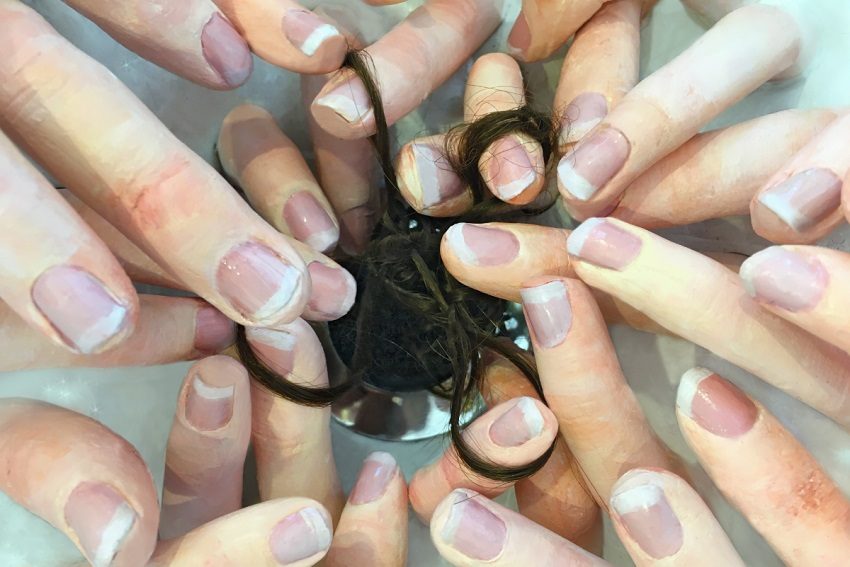Fiona Roberts and the uncanny façade

John Neylon examines the work of Fiona Roberts, a local artist using multiple media to probe the difference between reality and what we perceive it to be.
A friend told me that I have a couple of travellers or spirits in my house. Not to worry. They are there in a ministering role apparently. Nothing sinister or malevolent. That may help explain why at certain times in the day or night, noises occur and the air moves for no apparent reason. Who knows. And if indeed the faeries of a now distant Celtic ancestry want to come calling — ‘biodh sé amhlaidh’ (so be it).
But, relocate a sense of someone or something else ‘being there’ into the zone of uncertainty — even dread — and all of a sudden the cosy reassurance of being home is replaced by that of the uncanny.
Now here’s a term — the uncanny — or as savvy art writers and curators love to call it, ‘unheimlich’ (unhomely). Sigmund Freud wrote an essay on it in 1919 (‘The Uncanny’), which explored the idea of something being familiar and also alien at the same time.
From his thinking came the idea that something might first present as uncanny (even ‘unhomely’) but it might eventually lead to recognition of something very familiar that had been hidden or repressed. He called this a “class of frightening that leads back to what is known of old and long familiar”.
So, despite large chunks of popular culture, particularly films, that work all the gothic horror, slasher/exorcist/haunted house/zombie tropes designed to get your skin crawling, this thing called ‘the uncanny’ continues to attract serious creative attention, simply because it is so complex, so ambivalent and so now.

Fiona Roberts, Cinnabar Red (detail), 2018, earthenware, table, chairs, glass, resin, acrylic paint
Fiona Roberts’ art plies this territory. It’s in an early phase where the artist is working ambitiously and intently to build a body of work on which to reflect and decide on future directions.
Her previous (and first solo) exhibition Intimate Vestiges (2015) used a room setting as the organising device. A full-sized double bed faced a window framed by heavy drape curtain and matching pelmet. Various objects completed the décor, including a shag pile carpet, some tondo framed pictures, a bucket, chair, and coat on a wall rack. Given its slightly surreal referencing it might have been lifted off the set of The Grand Budapest Hotel.
The uncanny was abroad in a chair that incorporated hair and gaping mouths, a shag pile carpet consisting of grasping fingers, a hair brush sprouting a luxuriant crop of actual hair, two pillows straining to kiss each other and so on. This was six-pack surrealist territory with ambient nods to Duchamp, maybe Magritte, Meret Oppenheim, and more recent figures, Doris Salcedo and Mona Hartoum. The contemporary art and design world is awash with related anxiety-chic work — tagged as ‘The New Décor’.
Roberts’ current (from Monday, February 12) exhibition at Adelaide Central Gallery sees the artist drilling down into the notion of a room as a charged space in which the familiar and unfamiliar squirm in febrile association. There is a bed, a table, chair and so on.
Disembodied hands and limbs, sculpted in clay, play supporting roles to a series of small, sculpted objects suspended over the bed like embodiments of a dream. These objects, including models of a cloud, a bezoar stone and a padlock, are passing strange. Is their function to evoke some kind of necromancy — communicating with the dead? If so then this room goes from being plain weird to something akin to the interior of a mausoleum or a pharaonic tomb where everything is ritually arranged for an afterlife of service.
The wallpaper (and matching bedspread) weighs in here, crowded with visual motifs drawn from all kinds of dangerous plants (belladonna, oleander, fox gloves), dangerous minerals (asbestos, lead, cinnabar) and snakes, swimming in a sea of arsenic green. Malevolence is implied in a hand choking a dress to death.

Fiona Roberts, Arsenic Green, 2017, digital design printed on woven wallpaper
On a table a plate of gaping mouths (Cinnabar red) dares the viewer to grasp the ectoplasmic cutlery and tuck in. In this installation, fine-tuned surrealist tropes collide with schlock horror fantasy. It’s a delicate balancing act because the end game is not yet in sight.
Right now, Roberts is doing everything by working a tight set of motifs and putting materiality (such as the intricately embroidered dusty pink dress, bespoke wall paper (designed and commissioned by the artist) and resin cast cutlery, to the test. In the end it may well be this obsessive attention to materiality and detail which nuances meaning and mood, such as the ‘visceral slickness’ that writer Sera Waters discerned in earlier work, rather than theatrical installation.
The modern history of artists engaging with the uncanny through the agency of the domestic interior demonstrates that orchestrating viewers’ experiences by inviting them to slide down the rabbit hole into a slightly to hysterically askew world does not hold all the answers.
Perhaps some of them lie at the artist’s door, living as she does in a rapidly changing suburban area in which post war social (aka Housing Trust) dwellings are being clear felled, leaving large pockets of slightly uncanny, empty space where individuals and communities once felt ‘at home’.
Fiona Roberts
Façade
Adelaide Central Gallery
Friday, February 12 to Friday, March 9
fiona-roberts.com
acsa.sa.edu.au
Header image: Fiona Roberts, Porcelain White (detail), 2017, earthenware, enamel paint, hair, acrylic paint, varnish, metal fixings